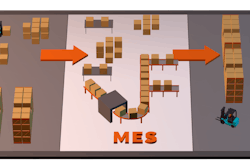
The last 18 months have truly tested the supply chain. Between a global pandemic, shipping bottlenecks and surprising inclement weather, the impacts were felt across various industries. There’s still a shortage of microchips and other consumer goods due to the events of 2020, even as we move on from many pandemic-era consumer needs.
Weather, gas line disruptions and cyberattacks are now affecting the production of new items, from chicken wings and meat supplies to even cheese. Whether it’s the result of a singular event or that of multiple mini disruptors, the supply chain has been struggling to keep up with demand, which makes disruption the new normal.
Even as experts attempt to navigate ongoing disruption, many supply chains today still have some components or areas that remain disconnected, which ultimately hinders the ability of all businesses involved (from the distribution center to the third-party logistics provider) to understand operations completely. To stay competitive, modern supply chain managing experts are focusing on better visibility and their use of data inside the warehouse, looking to provide better continuous improvement options to their teams as products go in and out of the warehouse – managing disruption before it becomes a transportation issue. Companies that have remained competitive during the last 18 months are turning to warehouse visibility to provide warehouse operators with valuable insights needed to turn analytics data into real-time, actionable process improvements.
Many leading supply chain experts have found that continuous improvement processes need just that – their own continuous improvement. To that point, a recent industry survey revealed where inefficiencies are taking place within the warehouse, and where a lack of real-time, easy-to-use analytics data is still preventing operators from making integral, real-time decisions.
Survey results for improved insights
In March, a Merit Mile survey revealed that over 75% of executives are seeing an increase in efficiency from implementing warehouse visibility technologies, with a quarter seeing between a 10-15% increase, and more than half seeing between a 5-10% increase.
In addition, one-third said they’re seeing a 10-15% increase in operational savings and another half said they’re experiencing a 5-10% operational cost savings as a result of warehouse visibility technologies that were implemented.
Finally, nearly 70% of organizations said they need better visibility into the procurement functions of their warehouse, followed by production and labor (65%) and fulfillment (37%).
Supply chain systems globally are feeling pressure of various types, with everything from constrained transportation systems, labor workforce challenges and supplier material shortages. What this survey shows is that thousands of supply chain executives realize that the warehouse is central to the entire supply chain operation. Incorporating better visibility regarding what data means to their operation will enable quicker decisions in real-time.
Transitioning to new supply chain strategies
Using the data gathered, warehouse executives can now view what they need to implement and improve in order to create the best visibility for warehouse operators. With it now being made clear that almost all supply chain systems need a makeover, most companies have already begun transitioning to new and improved strategies.
Over the next 12-24 months, 72% of businesses said they will be focused on aligning traditional supply chain strategies with both digital and analytics solutions. Nearly 64% said they’ll be focused on defining an advanced supply chain systems strategy. Another 34% said their focus will be on executions and refinement of newly installed systems and solutions.
Half of all companies polled said they plan to implement warehouse visibility technologies over the next 12 months. One-third of those companies polled said they will be considering the implementation of such systems. These steps are just the first of many to come in order to perfect the supply chain systems and reduce the visibility issues of the supply chain.

















